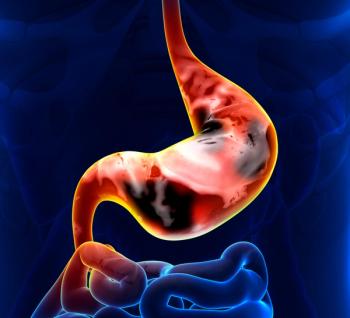
Oncology NEWS International
- Oncology NEWS International Vol 12 No 12
- Volume 12
- Issue 12
Single-Fraction RT Effective for Painful Bone Metastases
SALT LAKE CITY-A single fraction of 8 Gy of radiation therapy is as efficacious as 30 Gy delivered in 10 fractions for palliation of painful bone metastases and causes less acute toxicity, reported William F. Hartsell, MD, at the 45th Annual Meeting of the American Society for Therapeutic Radiology and Oncology (plenary session, abstract 1).
SALT LAKE CITYA single fraction of 8 Gy of radiation therapy is as efficacious as 30 Gy delivered in 10 fractions for palliation of painful bone metastases and causes less acute toxicity, reported William F. Hartsell, MD, at the 45th Annual Meeting of the American Society for Therapeutic Radiology and Oncology (plenary session, abstract 1).
In the phase III randomized trial (RTOG 9714), two thirds of patients in both groups had partial or complete relief of their pain at 3 months; the only tradeoff of the single-fraction strategy was a somewhat higher rate of retreatment, said Dr. Hartsell, medical director of radiation oncology, Advocate Lutheran General Hospital, Park Ridge, Illinois.
Patients enrolled in the trial had breast or prostate cancer; moderate-to-severe self-reported pain (a worst score on the Brief Pain Index of 5 or higher); radiographic evidence of metastases at painful sites; stable systemic therapy in the prior month; and a life expectancy of greater than 3 months. None had received prior palliative radiation therapy at painful sites or had cord compression, radicular symptoms, or pathologic fractures.
"Patients were entered onto this study from 160-plus institutions around the United States and Canada, so this is truly a collaborative effort throughout North America," Dr. Hartsell remarked.
Outcomes were compared for 454 patients treated with 8 Gy in a single fraction and 443 patients treated with 30 Gy in 10 fractions. Patients in the two groups were similar with respect to age (mean, 65 years), sex (1:1), race (about 75% white and 15% black), and functional status (Karnofsky performance status score of 80 or lower in about 75%).
The groups were also well balanced with respect to the distribution of four prespecified stratification variables: number of painful sites (solitary vs multiple); skeletal location of the site(s) (weight-bearing vs non-weight-bearing); bisphosphonate use (yes vs no); and initial worst pain score (5 to 6 vs 7 to 10).
Overall, about half of patients had solitary painful sites and sites located in weight-bearing bones; nearly three fourths had worst pain scores of 7 to 10, and about one fourth were taking bisphosphonates.
Study Results
At 3 months, the majority of patients in both the single-fraction (65%) and multifraction group (66%) had either a partial response (a 2-point improvement in worst pain score) or a complete response (a score of 0 on at least two consecutive assessments), Dr. Hartsell said. Absolute scores indicated that half of patients in both groups had no or only mild pain at that time. In addition, when patients were stratified according to the four prespecified variables, rates of complete pain relief did not differ between groups. One third of patients in each group were not taking narcotics, he said.
Patients in the single-fraction and multifraction groups had a similar median survival time (9.1 and 9.5 months, respectively) and similar 1-year survival rates (41% vs 42%), Dr. Hartsell said.
The rate of acute toxicity was significantly lower among patients in the single-fraction group than among those in the multifraction group; the rate of late toxicity was similar. Pathologic fractures within or adjacent to the treatment field occurred with equal frequency in the two groups.
Patients in the single-fraction group were significantly more likely than those in the multifraction group to need in-field retreatment by 3 months (10% vs 4%). "This 2:1 incidence of retreatment was maintained all the way through the 36 months of follow-up," he noted.
Dr. Hartsell pointed out that the patients in the study had relatively advanced disease. "These are not patients who just had metastatic disease diagnosed," he said, adding that better results might be achievable with earlier delivery of radiation therapy. He said that the team is still evaluating the health utilities and cost analysis, and that will help determine whether 8 Gy in a single fraction is the optimum treatment.
"My personal bias is that we have a treatment that is very effective and is much more convenient for the patient. A single dose of 8 Gy will provide identical pain relief with the caveat that a few patients will need additional treatment," Dr. Hartsell said. "If you were at a medical oncology meeting and a drug was presented that gave pain relief whether you gave it in 1 cycle or 10 cycles, and the only difference was that in the group that got 1 cycle, a small proportion had to get a second treatment, what would your conclusion be?"
Articles in this issue
about 22 years ago
Delirium, Dementia, Apathy Require Individualized Treatmentabout 22 years ago
Chemo-RT Before Surgery Ups Rectal Cancer Outcomesabout 22 years ago
Faster Radiation More Effective in Head and Neck Cancerabout 22 years ago
Aspirin Raised Pancreatic Ca Risk in Large Nurses’ Studyabout 22 years ago
Anemia Criteria in the Elderly:Is It Time to Re-Evaluate?about 22 years ago
Stressors on Caregivers May Be Overlooked, Making Them ‘Hidden Patients’Newsletter
Stay up to date on recent advances in the multidisciplinary approach to cancer.































































































